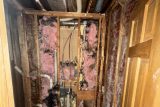Mold Or Mildew: Spot The Difference
Homeowners
2 years ago

We’ve talked a lot about the dangers of mold and how to address it if you find it in your home or business. Let’s make sure you know how to spot it and tell the difference between mold and mildew.
What Is Mildew?
It can get confusing trying to figure out what mildew actually is, as many people use that word interchangeably with mold.
Technically, mildew refers to a type of fungus that usually is dry, and powdery. It often looks gray or white and darkens over time. It has a musty scent similar to damp towels or socks. It grows on the surface of natural materials and thrives in humid parts of your home (like the bathroom or basement).
What Is Mold?
While both mold and mildew are fungi that grow in damp areas of your home, mold will look slimy or fuzzy instead of flat to the surface like mildew. Mold burrows under surfaces, rather than staying on top of surfaces the way mildew does, which is what makes it more dangerous to your home’s structure.
Common Spaces To Find Mold Or Mildew
Damp areas of your home are common culprits for mold and mildew to develop, so be sure to regularly check them:
- Crawl Spaces
- Basement Walls & Ceilings
- Around Bathtubs & Showers
- Under Carpet
- Near HVAC Vents
- Near Drainpipes & Gutters
How To Remove Mildew
While mildew doesn’t have the same serious health risks that come along with mold, you still want to make sure it isn’t growing in your home. Unchecked mildew can still damage surfaces in your home and caused mild health problems like headaches and coughing.
The great news is that mildew can often be treated with household cleaning products. Getting rid of mildew generally can be accomplished with a scrub brush and a mildew cleaner like RMR-86 Instant Mold & Mildew Remover.
What If It’s Mold, Not Mildew?
If you aren’t sure whether the fungus you’ve found in your home is mold or mildew, we offer mold removal inspections to put your mind at ease.
If you’ve inspected the damp areas of your home and are sure you’re seeing mold growth, not mildew, address it immediately to avoid mold continuing to damage your home and affecting your health.
If you’re considering cleaning mold in your home yourself, please click below to make sure you do so safely and are ready to call in professionals as needed.
Call Lake City Restoration For Help
Finding mold or extensive mildew in your home is always stressful. Remember, our expert restoration professionals are here 24/7 to answer your questions and help you navigate the insurance and restoration process.
Our services include mold restoration, water damage cleanup, fire damage restoration, storm damage repair, and other necessary restoration services.




